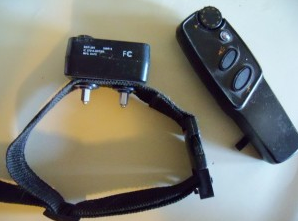E-collars– Why I Never Want to Use Them Again

No matter where we stand on the training spectrum, from purely positive, to balanced or traditional, we all want the same thing: enhancing the behaviors that we want and decreasing those that we deem problematic, for the benefit of both the dog and owner. As results driven creatures, we’re looking for the quickest and most efficient ways to achieve those goals. But how we chose to get there, will make a world of difference for the dog and for his relationship with his owner. E-collars can sometimes be effective in stopping problematic behaviors, in the short run, but can also have many side effects that could be worse than the behaviors they’re trying to address. I’ve been training dogs for so long, that I have, in my earlier days, used shock collars, so I understand the reasons behind their use.
I have read many reports advocating for the use of e-collars. E-collars are sometimes compared to a tap on the shoulder (Pendell, unpublished), with the goal to simply get the dog’s attention. Their advocates have claimed they are a gentle and perfectly appropriate teaching tool; leading to a happier dog and contributing to enhancing the relationship between dogs and owners.
As much as I believe that today’s e-collars are meant to be safe in normal uses, I don’t believe that they’re harmless. A tap on the shoulder may stop a dog when occasionally barking for attention, but it will not inhibit strong emotional reactions unless the stimulation is high enough to make an impression. The reason why e-collars can be effective is because they are so unpleasant that the dog will think twice before repeating the behavior that got punished. Research has shown that when stimulated (or shocked), dogs displayed the following behaviors: lowering of the body posture, yelps, tongue flicking, redirected aggression and avoidance, all signs of stress, fear and pain (Matthijs & al., 2004). There is no doubt in my mind that these collars are nothing else other than a powerful punishment tool.
While I’ve witnessed their immediate effectiveness, I have also watched many dogs get stimulated for no reason at all. Owners with little experience of training and handling of that type of equipment will not always take sufficient precaution to trigger the collar at the right time. They may stimulate the dog by accident, thus making the unpleasant sensation random and unavoidable. The potential to learn anything from the situation has just been annihilated.
Even in the best of worlds, if only experts were to use such devices, I would still choose to stay away from them. With today’s advances in animal behavior science, we can no longer accept the simplistic interpretations of so called dominant/aggressive reactions. Most aggressive behaviors are emotional responses to what is considered a threat to what they value, including their own safety. So punishing in any way will only increase the underlying emotion: fear. If we apply a very strong inhibitor, we will stop the behavior, but we haven’t taught our companion that the situation is safe, on the contrary, we have just made it worse. The quick fix now has the potential to create even more problems down the road. The dog may one day put teeth on the intruder without prior warning, since barking or growling has been inhibited.
When it comes to training the dog to come when called or stay on a property (in the case of invisible fences), the application of punishment, even when effectively used, also has side effects, as it will also generate stress and negative emotions about the situation itself. If we were to learn mathematics while trying to avoid being scolded or punished in any way, we would quickly develop very negative feelings about our teacher and about mathematics in general. Research indicates that even when dogs are trained by means of punishment, those who experienced e-collars are more stressed than the others who didn’t experience e-collars. Those dogs will continue to show signs of stress anytime the owner is present, even outside of the training situation (Matthijs & al., 2004). A relaxed dog that is not on the constant lookout for an unpleasant feeling will be less likely to display many problematic behaviors, including those we’re trying to stop.
I’ll be writing more on the effects of using punishment in a future blog, but for now, the question becomes about what we really want to teach the dog. Is it just about the result? And if it is, shouldn’t we apply scientifically proven methods that are not only more effective but that will truly enhance the dog’s life while building trust and positive feelings for his owner? A new comparative study from a veterinarian group in the UK (Blackwell & al., 2012), between owners who have used e-collars or punitive techniques as opposed to reward based methods to solve recall and chasing problems showed that those using rewards had a significantly higher rate of success over the two other groups (fig. 1). Technology can often support our training and give us quicker results, but let’s make sure of its positive effect on the dog before we adopt it.
Fig 1: The use of electronic collars for training domestic dogs: estimated prevalence, reasons and risk factors for use, and owner perceived success as compared to other training methods
In a world where we have been told that punishing a behavior is how you get rid of it, some have justified the use of e-collars. However, we now know that punishment tends to increase problems, not diminish them (Herron & al., 2009). Dogs, just like humans, are living, feeling and emotional creatures. We need to step away from the old disproven belief that dogs learn best when shown who’s boss through means of punishment and examine the true effects of e-collars. Since our understanding of canine psychology has vastly increased over the past 10-15 years, and has given us more effective ways to treat behavior or training issues, we can no longer justify the use of e-collars. Such devices have been shown to affect the dog’s well being as well as our relationship with them. As many others today I never want to use e-collars again.
Jennifer Cattet. Ph.D.




Leave a comment